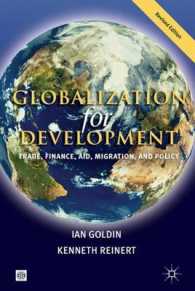- ホーム
- > 洋書
- > 英文書
- > Religion / Ethics
Full Description
Are the richness and diversity of rituals and celebrations in South Asia unique? Can we speak of a homo ritualis when it comes to India or Hinduism? Are Indians or Hindus more involved in rituals than other people? If so, what makes them special? Homo Ritualis is the first book to present a Hindu theory of rituals. Based on extensive textual studies and field-work in Nepal and India, Axel Michaels argues that ritual is a distinctive way of acting, which, as in the theater, can be distinguished from other forms of action. The book analyzes ritual in these cultural-specific and religious contexts, taking into account how indigenous terms and theories affect and contribute to current ritual theory. It describes and investigates various forms of Hindu rituals and festivals, such as life-cycle rituals, the Vedic sacrifice, vows processions, and the worship of deities (puja). It also examines conceptual components of (Hindu) rituals such as framing, formality, modality, and theories of meaning.
Contents
Preface ; Acknowledgements ; Abbreviations ; Plates and Figures ; Pronunciation of Indian Words ; Introduction ; Part I: Framing ; 1. The Beginning of Rituals ; 1.1 The Solemn Intention (samkalpa) ; 1.2 Greeting and Ritualized Greeting (namaskara) ; Conclusion ; Part II: Formality ; 2. Repetitive Rules (vidhi) ; 2.1 The Grammar of Rituals ; 2.2 A Preliminary "Grammar" of Newar Life-cycle Rituals ; 2.3 Rituals in Handbooks (paddhati) ; 3. Agency in Ritual ; 3.1 Ritual Competency (adhikara) ; 3.2 Atonements for Ritual Mishaps (prayascitta) ; 3.3 The Comic Side of Ritual Formality ; 4. Performed and Played Rituals (lila) ; 4.1 Music and Ritual Music ; 4.2 Dance and Ritual Dance ; 4.3 Emotions and Ritual Emotions ; Conclusion ; Part III: Modality ; 5. Individualized and Domestic Rituals (samskara) ; 5.1 The Boy's Initiation ; 5.2 The Girl's Initiation ; 5.3 The Marriage ; 5.4 Death Rituals and Redemption ; 6. Collective and Public Rituals ; 6.1 Temple Festivals (utsava) ; 6.2 Vows (vrata) ; 6.3 Pilgrimages and Processions (yatra) ; 7. Transcendence in Rituals ; 7.1 The Vedic Sacrifice (yajna) ; 7.2 The Fire Sacrifice (homa) ; 7.3 Worship and Prayer (puja) ; 7.4 E-darshan and Cyber-puja ; Conclusion ; Part IV: Meaning ; 8. Meaning and Function ; 8.1 The Cultural Studies Approach ; 8.2 The Cognitive Sciences approach ; 9. The Purvamimamsa Theory of Ritual Efficacy ; Conclusion ; Part V: The Hindu Path of Ritual-Summary ; Appendix: Automatic Detection of Ritual Structures ; Glossary ; References







